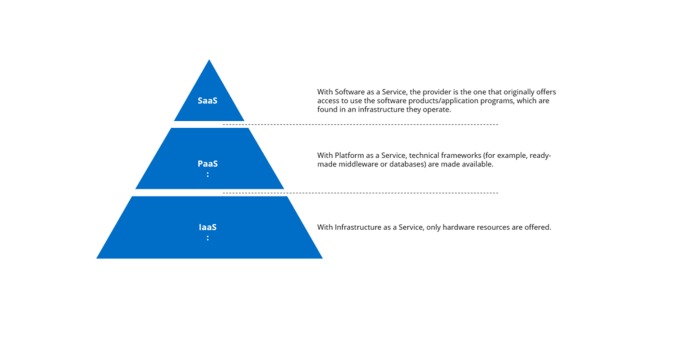19. May 2022 By Stefan Rogge and Alexander Frommelt
Lost in the clouds
Cloud readiness in the insurance industry
It is no longer possible to imagine IT projects without the cloud, regardless of what industry you’re talking about. New business models offer advantages in terms of scalability, stability and security, which deliver benefits across the cost structure of the IT system landscape. In many customer situations, the cloud is used as an all-purpose term or even as a buzzword. It loses its core meaning. Our blog post takes up the issue from an insurance company’s point of view and answers questions like what is the cloud and what does it mean for me. Employees from the IT and other specialist departments who read this article will gain a common understanding of the technical terms, avoid misunderstandings at joint workshops and be able to further explore the topics relevant to them in a targeted manner.
What is the cloud? What is it not?
As described above, the term ‘cloud’ is discussed in different contexts or at different levels of abstraction. This makes it difficult to contextualise the subject correctly, especially for colleagues or clients with a technical background.
Under our basic definition of the term, ‘cloud’ means the Internet-based provision of storage space, computing power or application software as a service, that is, the abstraction from physical infrastructure to infrastructure as code. Hidden in this statement are different touch points with corporate IT.

The cloud models and how they interrelate
What does ‘cloud’ mean for my software solutions?
The term ‘cloud’ primarily means an operating model. However, to operate a software solution in the cloud, it must first be set up and adapted specifically for this purpose.
The technology stack used by adesso to implement new software solutions takes this into account and addresses challenges relating to cloud operation, providing a solid foundation for software operation ‘in the cloud’. However, not all applications at insurance companies are based on this modern technological approach. Existing applications are largely monolithic and therefore not suitable for out-of-the-box operation in the cloud. That being said, this operating model offers the greatest added value where software solutions can be scaled flexibly to use.
This creates challenges relating to the software architecture and when it comes to setting up the necessary operating structures, which we will discuss in greater detail in one of the blog articles to come.
I use a platform. Isn’t that also the cloud?
Using a central standard solution such as a CRM system also brings with it the need to address cloud-related challenges. That’s because companies that offer standard solutions, one example of this being Salesforce, now only provide them in the cloud or see the cloud as the preferred business model. The on-premises solution they offer only provides a limited number of functions and services. This presents similar issues with regards data protection, data security and the implementation of applicable VAIT regulations that you would also encounter with software solutions that are developed in-house.
Is Software as a Service also a cloud solution?
While the term ‘cloud’ is primarily understood as a generic term for the provision of resources outside of your own data centre, Software as a Service (SaaS) is the most advanced form of cloud use. A provider ‘leases’ access to a full-feature software solution. The entire service is made available in the cloud, and it is centrally managed by the provider.
The versions of the cloud outlined above demonstrate that it is not only a trend in technology, but also in business. Recognising the benefits and new opportunities that the cloud offers for the insurance sector and adapting them to insurance operations will have a major impact on insurers’ market opportunities in the coming years.
The benefits and objectives of cloud solutions help deliver the best possible service experience to an application’s users who are the focus of all activities. This change in philosophy extends from the application concept to the operation of software in the cloud. Along with that it is also reflected in the technical architecture. If a user’s needs change, it is necessary to respond quickly to this in order not to lose them as a customer. Time-to-market and all that this entails are in the back of the developer’s mind whenever designing an application in the cloud.
Cloud users have no direct control over infrastructure components, networks or services on which they are built. From the insurance company’s perspective, there is no way for them to guarantee the availability of infrastructure on their own, meaning that system failures or outages could be expected at any time. To have high-availability cloud applications, you need to be able to deal with these challenges by way of the underlying infrastructure. System failures are by no means rare. They are a standard scenario that must be considered accordingly.
Conclusion
The cloud requires more than just putting an application in a container. Without a plan or a clear definition of guardrails, standardisation and an understanding of the business, you will not achieve the benefits in terms of elasticity, stability, security and availability that the cloud offers. For this to happen, it is extremely important to establish the boundaries of the term ‘cloud’ and consider it in the context of the insurance business. In this way, the company’s departments learn about the opportunities as well as the challenges that this new operating model presents.
Recognising the benefits and new opportunities that the cloud offers for the insurance sector and adapting them to insurance operations will have a major impact on insurers’ market opportunities in the coming years.
In our series of blog posts, we will therefore be taking a closer look at different aspects from the perspective of insurance and financial service providers.
You can find more exciting blog posts from the adesso world in our previous blog posts.


